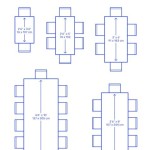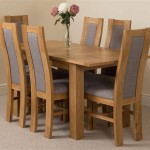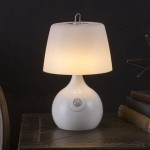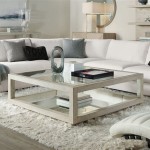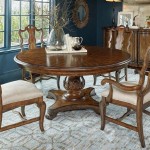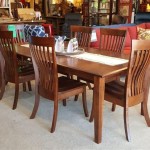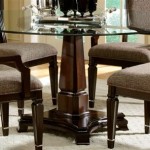Determining the Optimal Height for a Side Table
The selection of furniture for a living space requires careful consideration of both aesthetic appeal and functional utility. Among the various elements that contribute to the overall design and usability of a room, the side table plays a significant role. Its purpose is multifaceted, often serving as a resting place for beverages, books, lamps, or decorative items. Crucially, the height of a side table directly impacts its convenience and integration within the surrounding furniture arrangement. Therefore, determining the optimal height for a side table is paramount to achieving a harmonious and practical living environment.
The appropriate height of a side table is not a fixed measurement but rather a variable dependent on the height of the adjacent seating. A side table that is too low will require excessive bending to access items, while one that is too high may appear visually awkward and render it difficult to reach items comfortably. A well-chosen side table provides a convenient surface without requiring undue strain or interrupting the flow of conversation. By understanding the key factors influencing side table height, individuals can make informed decisions that enhance the functionality and aesthetics of their living spaces.
Matching Side Table Height to Sofa or Chair Armrests
The most critical factor in determining the ideal side table height is the height of the armrests of the adjacent sofa or chair. The goal is to select a side table that is either level with or slightly lower than the armrest. This configuration allows individuals to easily place and retrieve items without excessive reaching or straining. A difference of a few inches is usually acceptable, but a significant disparity can lead to discomfort and inconvenience.
For sofas and chairs with armrests that are approximately 24 to 30 inches high, a side table in the range of 22 to 28 inches is often suitable. However, it is imperative to measure the actual height of the armrests rather than relying on general estimations. Different furniture styles and manufacturers use varying dimensions, and even slight variations can impact the overall comfort and usability.
When selecting a side table for multiple seating options with differing armrest heights, it is often advisable to choose a height that complements the most frequently used seating. Alternatively, consider using multiple side tables with varying heights to accommodate different chairs or sofas. This approach provides flexibility and ensures that each seating area has a conveniently positioned surface.
In situations where the armrest height is particularly low, a smaller side table or even a coffee table may be a more appropriate choice. Conversely, for chairs or sofas with exceptionally high armrests, it may be necessary to opt for a taller side table or explore alternative solutions such as adjustable tables or pedestal tables that can be customized to the desired height.
The material and construction of the side table also play a role in determining its suitability. A sturdy and stable table is essential to prevent tipping or wobbling, especially when used to hold drinks or other fragile items. Ensure that the table's base is sufficiently wide and that the overall design is balanced and secure.
Considering the Functionality of the Side Table
Beyond the armrest height, the intended function of the side table is another essential consideration. A side table used primarily for holding lamps and decorative items may not require the same proximity to the seating as one used for frequently accessing drinks or remote controls. The anticipated use will influence not only the height but also the size and style of the table.
If the side table is intended to serve as a nightstand, the optimal height should align with the height of the mattress. This allows for easy access to items such as books, glasses, or a phone without requiring the user to sit up or reach excessively. A nightstand that is significantly lower or higher than the mattress can be uncomfortable and inconvenient.
For side tables intended for use near a home office setup, the height should be compatible with the desk or workstation. A side table at desk height can provide additional workspace for laptops, documents, or other office supplies. This creates a seamless and integrated work area that promotes productivity and efficiency. Avoid side tables that are too low. Side tables that are too low require individuals to hunch over, leading to discomfort and potential strain.
Another aspect of functionality is the storage capacity of the side table. Some side tables feature drawers, shelves, or cabinets that provide additional storage space for books, magazines, or other items. When selecting a side table with storage, consider the accessibility and usability of these features. Ensure that the drawers or shelves are easily accessible and that the storage space is adequate for the intended purpose.
The placement of the side table relative to the seating is also important. The side table should be positioned within easy reach of the user without obstructing the flow of traffic or creating a cramped feeling in the space. Consider the overall layout of the room and ensure that the side table complements the existing furniture arrangement.
Aesthetic Integration and Design Considerations
While functionality is a primary concern, the aesthetic integration of the side table within the overall design scheme of the room is equally important. The side table should complement the style, color palette, and materials of the other furniture and décor. A well-chosen side table can enhance the visual appeal of the space and contribute to a cohesive and harmonious design.
The style of the side table should align with the overall design aesthetic of the room. For a contemporary space, a sleek and minimalist side table with clean lines and geometric shapes may be appropriate. In a more traditional setting, a side table with ornate details, carved legs, or a rich wood finish may be a better choice. The color of the side table should also complement the existing color scheme. Neutral tones such as white, gray, or beige are versatile and can blend well with a variety of décor styles. Alternatively, a pop of color can be used to add visual interest and create a focal point.
The materials used in the side table's construction should also be considered. Wood, metal, glass, and stone are all common materials used in side table design. Each material has its own unique characteristics and aesthetic qualities. Wood provides warmth and natural texture, while metal offers a more modern and industrial look. Glass can create a sense of openness and transparency, while stone adds a touch of elegance and sophistication.
The shape of the side table can also influence its visual impact. Round, square, rectangular, and even irregularly shaped side tables are available. The shape should complement the surrounding furniture and the overall layout of the room. Round side tables can soften the look of a space and create a more inviting atmosphere. Square or rectangular side tables provide a more structured and formal appearance.
Finally, consider the scale of the side table in relation to the surrounding furniture. A side table that is too small may appear insignificant and get lost in the overall design. Conversely, a side table that is too large can overwhelm the space and create a cluttered feeling. The scale should be proportional to the size of the seating and the overall dimensions of the room. By carefully considering these aesthetic factors, individuals can select a side table that not only functions well but also enhances the visual appeal of their living spaces.

Tall Side Table For Sale Wholesale Furniture Supplier Vasagle

Stowe Solid Wood Side Table 22

High Low Modern Metal And Enamel Tables Remodelista

Tall Side Table 30 Inch High End Small Entryway Bedside For Living Room And Bedroom Greige Black

Yaheetech Tall End Table Accent 30 In Side With Strong Wooden Shelves Gray

C Shaped End Table A Diy Project That S Easy To Do On Weekend Silver Martini

Cottswolds 27 1 4 High Brown Wood Accent Table

C Shaped Sofa Side Table Modern End For Living Room Bedroom Ebay

Relate Side Table Functionality In Design

Ton Side Table Northern


